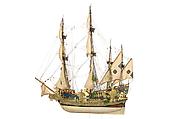The Wine Dark Sea, DD
Hew Locke British
Not on view
The Wine Dark Sea, by British-Guyanese artist Hew Locke, is an installation comprised of seven individual sculptures, five of which premiered at his 2016 exhibition at Edward Tyler Nahem Fine Art in New York City. The title of the installation is a nod to Homer’s Illiad and Odyssey (both of which use a Greek epithet that serves as the installation’s title) as well as to Derek Walcott’s epic poem Omeros, from 1990, itself a reference to Homer, albeit one that plays out in the Caribbean instead of the Aegean. Crafted from wood, metal, fabric, and found materials, each sculpture in The Wine Dark Sea takes the form of a vessel which is in turn based on a particular prototype. The Wine Dark Sea, U references a Coast Guard skiff. The Wine Dark Sea, AA, takes its inspiration from a more pedestrian sailing boat. The Wine Dark Sea, CC alludes to a stock military boat. The Wine Dark Sea, DD is a model of Sir Francis Drake’s The Revenge, a flagship pitted against the Spanish Armada. (This sculpture evokes more generally the large sailing galleons of the age of discovery and conquest in the 15th through the 18th centuries). The Wine Dark, H is based on a Cuban refugee boat. Boat X (from The Wine Dark Sea, Group 9) is inspired by the boats deployed in the 1979 film Apocalypse Now, the same sorts of vessels employed on military and colonial expeditions around the world. Finally, Boat F (from The Wine Dark Sea, Group 6) typifies the kind of cargo transport used along the Amazon, the site of extractive industries as well as colonial enterprise. Most of the sculptures are embellished with a profusion of chains, plastic flowers, national and organizational coins, medals, imperial regalia, military uniform badges, and the like, all of it rife with historical and symbolic import. A brass plaque on one of the ships alludes directly to a 16th-century German carving of a skeleton, for instance, while another, on The Wine Dark Sea, DD evokes the Queen Mother Pendant Mask, a 16th century ivory mask from Benin, an example of which is in The Met’s collection. The addition of cargo sacks, bags, and clothing suggests the presence of crew members who are otherwise absent. This, in turn, evokes mysterious, perhaps fatal events left to the imagination. Locke’s sculptures are meant to hang from the ceiling, creating a dense, fantastical installation—a kind of suspended flotilla that immerses viewers in both art and history. Like ships themselves, Locke’s procession conjures up a variety of narratives around maritime trade and exchange as well as migration, displacement, slavery, smuggling, colonialism, and military conflict. Locke has referred to sculptures such as these as "votive ships," both "offerings and invocations"[1] inspired by the x-votos he encountered in churches in the Caribbean and beyond. Together and individually, The Wine Dark Sea speaks to the events and catastrophes, many of them involving displaced, disenfranchised peoples of the world, that have taken place on the planet’s many bodies of water.
[1] Zoe Lukow, Hew Locke: The Wine Dark Sea [brochure] (New York: Edward Tyler Nahem Fine Art, LLC, 2016), p. 3.
Due to rights restrictions, this image cannot be enlarged, viewed at full screen, or downloaded.

